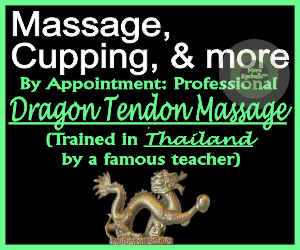W_cheape
New Member
Here is a section from White & Cummings (2008) on the difficulty in using double blind placebo-neutal trials to measure acupuncture outcomes.
A placebo must be indistinguishable from the real treatment, but it must
be inert. Unfortunately, there is no placebo for an acupuncture needle: anything that feels like a needle inevitably has a physiological effect. For many years, researchers have displayed great invention in trying to find inactive controls, but it is now clear that any stimulus on the skin, even just pressure with the blunt end of a needle, can have profound effects on the limbic system when it is being used in a therapeutic context, i.e. pretending to be a real treatment (Pariente et al 2005). While it is true that a sharp, penetrating needle has a greater effect than blunt pressure on the skin the fact remains that the blunt pressure will have treatment effects of its own through widespread activation of the limbic system: a blunt needle is not an inactive placebo.
This creates a problem, which is that the effect of the blunt needle is
almost as large as the effect of the real needle. The difference
between the two is often much smaller than the difference between a drug and a placebo drug. Therefore, acupuncture studies that are too small, or not very carefully designed, will fail to reveal this small difference. Studies like this could be interpreted as showing that acupuncture has no real effect, when in fact the acupuncture has an effect, but more patients are required to show the effect. This is known as a type 2 error – the failure to reveal an effect that does actually exist, because of inadequate statistical power, usually because the number of subjects is too small.
A placebo must be indistinguishable from the real treatment, but it must
be inert. Unfortunately, there is no placebo for an acupuncture needle: anything that feels like a needle inevitably has a physiological effect. For many years, researchers have displayed great invention in trying to find inactive controls, but it is now clear that any stimulus on the skin, even just pressure with the blunt end of a needle, can have profound effects on the limbic system when it is being used in a therapeutic context, i.e. pretending to be a real treatment (Pariente et al 2005). While it is true that a sharp, penetrating needle has a greater effect than blunt pressure on the skin the fact remains that the blunt pressure will have treatment effects of its own through widespread activation of the limbic system: a blunt needle is not an inactive placebo.
This creates a problem, which is that the effect of the blunt needle is
almost as large as the effect of the real needle. The difference
between the two is often much smaller than the difference between a drug and a placebo drug. Therefore, acupuncture studies that are too small, or not very carefully designed, will fail to reveal this small difference. Studies like this could be interpreted as showing that acupuncture has no real effect, when in fact the acupuncture has an effect, but more patients are required to show the effect. This is known as a type 2 error – the failure to reveal an effect that does actually exist, because of inadequate statistical power, usually because the number of subjects is too small.




































































































